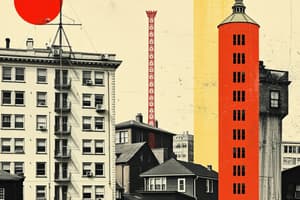Podcast
Questions and Answers
What is the primary goal of rent control policies?
What is the primary goal of rent control policies?
- To promote the development of new housing projects
- To reduce government expenditure on housing subsidies
- To increase the revenue of landlords
- To protect tenants from rapid rent increases and ensure affordable housing (correct)
What was the primary purpose of price controls during wartime?
What was the primary purpose of price controls during wartime?
- To prevent profiteering and ensure fair distribution of goods (correct)
- To reduce government spending on military equipment
- To increase government revenue through taxation
- To stimulate economic growth
What is a consequence of implementing a price ceiling below the equilibrium price?
What is a consequence of implementing a price ceiling below the equilibrium price?
- No impact on the market
- Surplus of the good or service
- Increase in the equilibrium price
- Shortage of the good or service (correct)
What is an example of rationing in the United States during World War II?
What is an example of rationing in the United States during World War II?
What was the name of the organization established in 1941 to regulate prices and rents in the United States?
What was the name of the organization established in 1941 to regulate prices and rents in the United States?
In which cities are rent control policies commonly implemented?
In which cities are rent control policies commonly implemented?
Flashcards are hidden until you start studying
Study Notes
Price Ceiling
Rent Control
- A type of price ceiling that regulates the maximum rent that landlords can charge for apartments or houses
- Implemented to protect tenants from rapid rent increases and to ensure affordable housing
- Examples: Rent control policies in cities like New York City, San Francisco, and Berlin
Price Controls in Wartime
- Implemented during wartime to control inflation and allocate resources efficiently
- Examples:
- During World War I and II, many governments imposed price controls to prevent profiteering and ensure fair distribution of goods
- In the United States, the Office of Price Administration (OPA) was established in 1941 to regulate prices and rents
Shortages and Rationing
- Consequences of price ceilings:
- Shortages: When the price ceiling is set below the equilibrium price, it leads to a shortage of the good or service
- Rationing: Governments or authorities may introduce rationing to allocate the limited supply of the good or service
- Examples:
- Gasoline rationing during World War II in the United States
- Food rationing in the UK during World War II
Studying That Suits You
Use AI to generate personalized quizzes and flashcards to suit your learning preferences.




